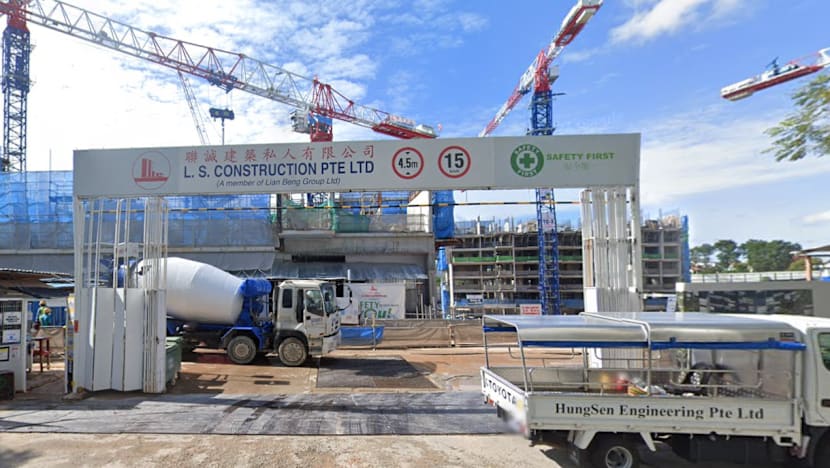Couple loses suit against condominium builder over vibrations that 'damaged' their house across the road
The first claimant, who has himself been in the construction industry for more than 50 years, testified about how the vibrations allegedly cracked his floor and made his lighting fixture sway.

Screengrab from Google Street View of the construction site at Serangoon North Avenue 1 in 2020.

This audio is generated by an AI tool.
SINGAPORE: A couple sued the builder of a condominium in Serangoon North, claiming that vibration-causing construction works that took place over more than two years had damaged their house across the road.
The builder, L S Construction, offered some repairs out of goodwill, patching up cracks and water seepage at the house, but the pair said the patched-up areas were "uneven and ugly".
The married pair, Mr Soh Chuan Swee and Madam Tok Beng Kee, sued the construction firm for performing the vibration-causing works and the repair works negligently.
However, in a judgment made available on Saturday (Oct 4), a judge threw out the suit, saying the claimants had failed to prove that the construction firm had performed either set of works negligently.
According to the judgment, the defendant was constructing "Affinity at Serangoon", a residential development comprising apartments and strata landed houses in Serangoon North Avenue 1.
The claimants live across the road from the construction site, in a house that was built between 2017 and 2018. There was a distance of around 12m between the site and the house.
Before the construction works began, a pre-condition survey of the claimants' house was conducted in October 2018 and showed that the house was generally defect-free at the time, although there were cracks observed in the walls and tiles.
In November 2018, the builder began demolition works at the construction site to remove the existing buildings, before carrying out piling works in 2019 followed by I-beam installation and extraction works from 2020 to April 2021.
I-beams are steel structures shaped like the letter "I", used for various purposes in construction.
According to the claimants, they first noticed damage to their house in October 2019, about two months after the piling period and before the I-beam period began.
This included cracks in a wall, glass blocks and floor tiles at their front porch, which resulted in water seeping through the cracks when it rained.
According to WhatsApp texts, the builder offered to perform repair works for the claimants after its employee inspected the claimants' house.
Based on a letter dated Jan 7, 2020 from the defendant to the claimants, the offer to perform the repairs was made on a "without prejudice and without admission of liability basis".
Before this, the claimants did not complain about any damage arising from the vibration-causing works. While the claimants pointed to dust that had gone into their house during the demolition period, and possible inadequacies in the barriers and netting installed at the construction site, this had nothing to do with the alleged damage caused by the vibrations, said District Judge Samuel Wee.
VIBRATIONS CRACKED FLOOR, MADE LIGHT SWAY: CLAIMANT
In March 2020, Mr Soh experienced vibrations in the house that allegedly caused cracks in the granite floor. This was when the builder was extracting I-beams from the ground.
Mr Soh testified that the vibrations were so strong that one of the lighting fixtures in his house started swaying vigorously over three days in March 2020.
Judge Wee said that while Mr Soh submitted video footage to support this, the footage was "not helpful" as it simply showed some swaying of the lighting feature, which could have happened for a variety of reasons given its dangling design.
The builder produced monitoring reports that showed that the vibrations at the perimeter of the construction site were lower than 2mm/s and within the limit of 5mm/s.
Due to the COVID-19 circuit breaker, where non-essential activities were banned, the builder did not inspect the alleged damage until September 2020.
After some discussions, the builder indicated that it was prepared to perform further repair works to address the alleged damage from the March 2020 vibrations, but suggested that they be done after all I-beams were extracted.
In March 2021, Mr Soh again experienced vibrations in his house, when the builder was extracting I-beams from the ground.
The builder provided monitoring reports to show that the vibrations at the perimeter of the construction site were again lower than 2mm/s and within the limit of 5mm/s.
In April 2021, the builder provided Mr Soh with a draft method statement setting out the scope of the proposed further repair works. These included repairs to cracks, painting and the application of waterproofing chemicals, but did not include works for cracks in the floor tiles.
Mr Soh was not satisfied with the statement and did not agree to it. As the parties were unable to agree on the scope of the further repairs, the builder decided not to provide further assistance.
The builder said it was initially prepared to perform the further repairs on a goodwill basis, but withdrew this offer because the claimants were relying on damage that "could not have been caused by the vibration-causing works".
JUDGE'S FINDINGS
Judge Wee found that the couple had failed to prove that the builder breached its duty of care, by failing to act in accordance with industry practices when performing the vibration-causing works.
"Vibrations are expected from the vibration-causing works," said the judge. "Indeed, the first claimant (Mr Soh), who has been a general contractor in the construction industry for more than 50 years, accepted during cross-examination that it is not unusual for such vibrations to be caused and clarified that his grievance lay with the alleged excessiveness of the vibrations."
However, evidence showed that the vibrations were within acceptable levels, said Judge Wee.
The builder produced monitoring reports based on two vibration monitors that were placed at the north perimeter of the construction site, and at the south, just across the road from the couple's house.
The monitors provided continuous monitoring of vibrations and show that the works did not exceed 2mm/s, well within the limit of 5mm/s.
This shows it was unlikely that the couple's house experienced vibrations in excess of 2mm/s, particularly since it was outside the perimeter of the construction site, said the judge.
"While the claimants contend that the monitoring reports are not accurate, they have produced no evidence to substantiate their assertion," said Judge Wee.
He said it was pertinent that the couple was informed by the Building and Construction Authority that it is "not in possession of any evidence that could suggest that the instrumentation data could have been adjusted or is in fact from (some) other work site".
The couple also failed to prove that the vibration-causing works caused the alleged damage to their house, said the judge.
He said Mr Soh's evidence was "speculative and lacked objectivity".
"Based on his experience in the construction industry, (Mr Soh) was aware that 'shrinkage cracks from expansion and contraction from a new construction and/or weather conditions are normal', which is why there is typically a defects liability period and accompanying warranties for new construction projects to deal with such issues," said the judge.
Despite this, he was "quick to assume" that the alleged damage was caused by the vibration-causing works, rather than "by inherent defects in the recent construction of the claimants' house, and did not conduct any investigations to substantiate his view objectively", said Judge Wee.
He said the evidence from the claimants' expert was also "unhelpful", as he confirmed during cross-examination that he was essentially reiterating the couple's views and had not undertaken any investigation of his own.
He also confirmed that he did not review the monitoring reports.
In contrast, the builder's expert testified that the couple's house was not exposed to a magnitude of vibrations that would ordinarily affect the building or induce damage.
He also testified that the alleged damage was not caused by the vibration-causing works, describing the damage as "cosmetic" rather than structural in nature.
As cosmetic damage is caused by vibrations between 8mm/s and 20mm/s, the vibration-causing works did not cause the damage to the couple's house, as the works produced vibrations of less than 2mm/s.
The judge noted that there were no such complaints from the owners of houses neighbouring the couple's house. This suggests that the damage may have arisen from some other cause, such as inherent defects in the claimants' house that had been recently constructed.
The October 2018 pre-condition survey showed that cracks had already manifested in the couple's house in September 2018, one month after the certificate of statutory completion for the house was issued in August 2018.
The judge said the claim that the builder had performed the vibration-causing works negligently fails, as the couple cannot establish at least two of the four required elements of negligence.
As for the claim that the builder had performed the initial repair works negligently, the builder denied negligence, saying it did not owe a duty of care as the works were done on a goodwill basis.
The judge said that while the works were performed on such a basis, the builder's choice to perform the work meant that it owed a duty of care to the couple.
However, the couple failed to prove that the builder breached its duty of care.
"As the defendant points out, the claimants have not specified the standard of care to be met for the initial repair works or how the defendant fell short of that standard," said the judge.
"It is insufficient for the claimants to merely opine that the initial repair works were done badly as 'all the patched-up areas were very uneven and ugly' and produce photographs that do not clearly demonstrate their position."
He dismissed this claim as well, and asked both sides to file submissions on costs.
The couple was represented by Mr Anil Murkoth Changaroth from ChangAroth Chambers, while the builder was represented by Ms Gina Tan, Mr Alson Tan and Ms Brenda Kylie Tay from Terra Law.














